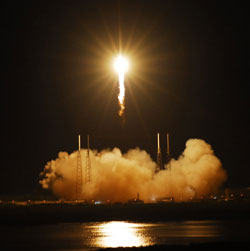
If you’re an early riser, you’re in astronomical luck in October! While Mars is fading rapidly in the western sky during the early evening hours, Venus and Jupiter dominate the early morning eastern sky. And if you live in mid to northern latitudes on Earth, you’re in for a special treat: the zodical light, or “false dawn.”
False Dawn
The false dawn looks like a faint, triangular-shaped light that stretches from the eastern horizon up into the sky above. It appears during the period of time between about 1 to 2 hours before sunrise at about this time of year. This year, the best time to view this spectacle is between October 13 and 27. To see it, go far from city lights on a clear, moonless night.
This strange celestial display is caused by the reflection of sunlight off of tiny particles of dust in space. The dust orbits the sun in the same way Earth does. So at this particular time of the year — when the days and nights are of roughly equal length — we view this dust when it is aligned vertically in our pre-dawn, eastern sky. A similar thing will happen six months from now, only the triangular shape of light will appear in the western sky, after sunset.
The Planets This Month
Venus is the ‘morning star’ — the bright point of light you’ll see toward the east before sunrise. Look for the giant planet Jupiter — in the consetllaton Taurus — toward the south, near the prominent constellation Orion, shortly before sunset. (If you live in the southern hemisphere of Earth, Jupiter will appear toward the north shortly before sunrise.) Jupiter will also appear as a bright ‘star’ in the night sky.
But fear not, fellow night owls, for you too can feast your eyes on some celestial treats! The planets Neptune and Uranus will be visible through binoculars and small telescopes during the evening hours this month. While you can see both Neptune and Uranus through a telescope, Uranus — strictly speaking — is just barely visible to the naked eye — but just barely! In order to see it, you’d need to go far from city lights and view it on a clear, moonless night. (And you better have good eyesight to boot!) We recommend sticking with your telescope or binocs!
Finding your star in the night sky
Stars are located within constellations, which are just areas of the night sky. Scorpius, Aries and Taurus are examples of constellations. Your Name A Star Live Star Certificate displays the name of your constellation. You can use our online World Constellation Guide to determine if you can see your constellation during the evening hours (between sunset and midnight). Of course, you’ll need a telescope to see your star. But you can see your constellation without the use of a telescope. You can also find your constellation by using our Virtual Planetarium™ astronomy software. A planisphere is another useful device.


